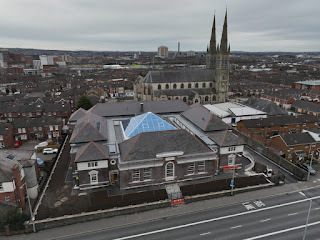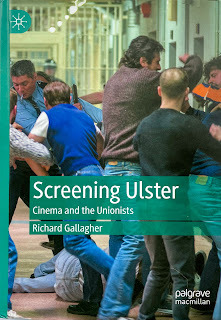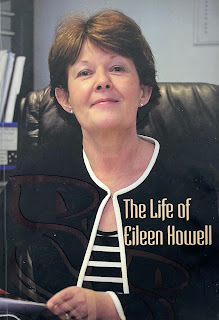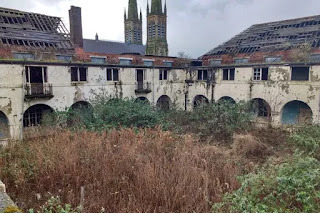At St Comgall's, Eileen's shining vision becomes a reality: A New look at the Cinema and Unionism
At St Comgall's, Eileen's shining vision becomes areality
St. Comgall’s/Ionad Eileen Howell in Divis St. willbe formally opened next week on Thursday the 22 June. In honour and memory ofEileen the refurbished building is being named after her.
Themulti-million pound project has been 21 years in the making. The transformationof what was for many years a derelict building has been amazing. All of thosewho have contributed in any way to its successful renovation should be veryproud of their efforts.
Just over 20 years ago St. Comgall’s, which standsin the shadow of Divis Tower, had fallen into a scandalous state of disrepair.It was regularly targeted by anti-social elements and the building was a blighton the local community and environment. As the MP for west Belfast I spoketo Eileen Howell in the Falls Community Council about the possibility ofturning St. Comgall’s into a community enterprise – similar to Conway Mill –that could be a resource for the community and create sustainable jobs.
Eileen was an experienced community activistand champion for West Belfast who put her considerable energy intotackling the endemic inequalities and injustices endured by the nationalistwest Belfast community. She was irrepressible, tireless and hugely respected asa champion of the rights of citizens and of the community. She had adeep-rooted belief in the imperatives of equality and human rights, and ofeconomic and social justice. These were her guiding principles. She was awarrior for working people.
Eileen saw the enormous potential of St.Comgall’s and she and the Board of the Falls Community Council jumped at theopportunity to regenerate and develop St. Comgall’s as a community andregenerative hub.
In May 1932 Saint Comgall’s was opened as aPublic Elementary School and built to the design of R S Wilshire who was thenthe education architect in the City. Saint Kevin’s School further up the Fallsis another of his healthy schools. His designs were revolutionary for theperiod with lots of light and air.
For the next six decades thousands of SaintComgall’s children passed through its doors. The building was at the centre ofmuch of the local sporting and cultural events during those years. The manygroup photographs that exist in the enclosed courtyard are evidence of the widespreaduse of the building by the GAA, civic organisations and the localconfraternity. The front hall which has now been lovingly restored was used fordances and bingo nights.
Uniquely the building bears the scars on its frontwall of the 1969 August pogrom in which unionist gangs, led by the RoyalUlster Constabulary (RUC) and its auxiliary force the B Specials attacked theFalls and the Clonard areas of West Belfast, as well as Ardoyne in NorthBelfast. Percy St. directly facing St. Comgall’s was largely destroyed, as wasDover St a short distance away. Residents were beaten and were fired on as theytried to escape. In St. Comgall’s an IRA Volunteer fired on the mob thwartingtheir effort to destroy the school and to attack the houses on that side of DivisSt. The bullet holes on its front wall are testimony to those events.
In 2002 the Falls Community Council purchased thebuilding with the assistance of Chuck Feeney’s Atlantic Philanthropies. Thosewho signed for the building included Liz Groves; Chrissie McAuley; John Fusco;Mike Ritchie; Ruth Tallion; Jane Craven; Eilish Rooney and Joe Nolan. Some ofthose involved in the project subsequently are no longer with us. IncludingEileen. But those I remember include John Quinn; Marie Maguire; SalBrennan; Mrs Timmons; Ciaran Kearney; Ciaran Quinn; Claire Hackett; andGerry McConville. I’m bound to have left someone out. If so I will rectify thatnext week.
Eileen and her colleagues worked tirelessly seekinglong term funding, talking to architects, developing plans, talking topotential partners, and engaging with the local community. For Eileen it wasthe perfect flagship gateway project into west Belfast.
Sadly two years later, in 2004 Eileen became veryill. She died on 12 June 2004 – her anniversary was on Monday. Her loss waskeenly felt by her family, by her husband Ted, her two sons Eamonn andProinsias and the wider family circle. Her death also robbed the west Belfastcommunity of a skilled and inspirational leader.
In the years since then the Falls Community Councilhas worked hard to make Eileen’s vision for St. Comgall’s a reality. Shewould be very proud of the St. Comgall’s building that has now emerged phoenixlike out of the ashes of the abandoned and derelict building.
St. Comgall’s/Ionad Eileen Howell is designed topromote economic, educational, social and cultural benefits for the people wholive and work in the local area and to promote good relations betweencommunities through the provision of a multi-use community hub. It is a stunningbuilding. If you want to see what it once looked like and what it looks likenow then follow this link https://www.belfastcity.gov.uk/stcomgalls
You will be amazed.

A New look at the Cinema and Unionism
Richard Gallagher’s ‘Screening Ulster: Cinema andthe Unionists’ is more than its title suggests. The book specifically focuseson the period from the 1980s. From the first page Gallagher sets hisexamination of how unionism has been portrayed in the cinema over the last 40years.
In his insightful and extensively researched bookGallagher’s perceptive analysis of political and cultural unionism, its senseof Britishness, of loyalism, of community concludes that this complexity islargely absent in the cinema portrayal. What we see on the screen is a “muchnarrower definition of the unionist identity that rarely escapes a polarisedrelationship with Irish nationalism.” Gallagher finds that “themany complications and contradictions within both the unionist identity andunionist perspectives of the Troubles” have been largely ignored.
 Where unionism is portrayed it has been primarilythrough “associations to Orangeism (parades, loyalist bands andbonfires)” and through sectarian violence. Orangeism and itstraditions are often presented as supremacist, sexist, intolerant anduncompromising. According to Gallagher the most dominant form of culturalexpression espoused by unionism is to be found in the loyalist bands thataccompany the orange parades.
Where unionism is portrayed it has been primarilythrough “associations to Orangeism (parades, loyalist bands andbonfires)” and through sectarian violence. Orangeism and itstraditions are often presented as supremacist, sexist, intolerant anduncompromising. According to Gallagher the most dominant form of culturalexpression espoused by unionism is to be found in the loyalist bands thataccompany the orange parades.
In addition, Gallagher asserts that the depictionof loyalist paramilitaries has increasingly dominated cinematic depictions ofunionists. This has been influenced by the actions of unionist death squadslike the Shankill Butchers. Consequently, in the cinema loyalists are oftenpresented as “monstrous and indiscriminate in their use of violence.” Theyare rarely ascribed with being politically motivated.
Gallagher believes that the crisis in unionism’sidentity has its roots in partition. He quotes unionist commentator Alex Kanesaying; “Because we lost the union between Britain and Ireland, becausewe were contained to six counties and a majority that we knew would not bestabilised at 30%, and because we thought things would grow against us, unionismbecame paranoid. It became insular and afraid of everyone.” It was inreality the outworking of the British colonial experience in Ireland.
Gallagher also references the tensions that existwithin unionism because of its contradictory and at times antagonisticrelationship with the British state. Its loyalism to Britain has always beenconditional. Unionist paramilitaries and political parties have a long historyof links to the British military, its intelligence services and in particularthe Conservative party. Collusion between unionist death squads and the Britishstate has long been a matter of British policy. However, that loyalty hasrarely been reciprocated by the British state.
A recent example of the dysfunctional relationshipbetween unionists and British governments, and especially the Tories, is thefrequency with which unionism has been abandoned, commitments given to itdiscarded and unionist parties often and very publicly thrown under the bus.
Boris Johnson’s resignation last week as an MP is areminder of one British Prime Minister who was wined and dined by the DUP andwho made promises, which he then broke. Remember his triumphant visit to theDUP’s party conference in 2018? Arlene Foster was delighted. Johnson wastalking their language. A hard Brexit and a hard border. But then the DUP wereditched and the hated protocol was produced.
Another example of a British Prime Minister dumpingunionism when it was no longer needed. If you have an interest in cinema, howit has dealt with unionism and what all of this means for unionist identitythen this is the book for you.
Screening Ulster: Cinema and the Unionists by Dr.Richard Gallagher is published by Palgrave MacMillan: https://link.springer.com/book/10.1007/978-3-031-23436-1
Gerry Adams's Blog
- Gerry Adams's profile
- 29 followers





